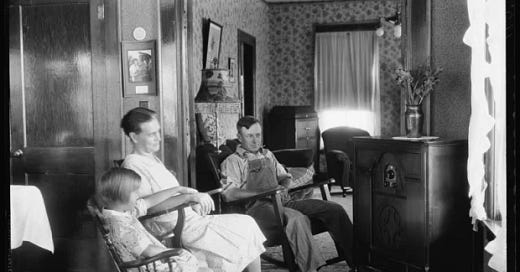American food history and culture has no shortage of fictional characters who want to influence your grocery purchases (Miss Chiquita, The Kool-Aid Man, Ronald McDonald) or even the way that we approach 20th Century cooking (Betty Crocker, Pillsbury Dough Boy. While some made their debut in magazines and in-store advertising, others rode into our home kitchen via radio and television.
I promise you that this is not another story about General Mills’ Betty Crocker, but rather a largely forgotten predecessor whose weekly radio program offered not only ideas about making nutritious meals in a time of national austerity, but also jokes, light news commentary, and housekeeping tips.
Meet Aunt Sammy
“Aunt Sammy” was the fictional creation of the US Department of Agriculture in the era of the Bureau of Home Economics. She was created and debuted in 1926 to be the friendly voice for a radio program aimed at farm and rural women called Housekeeper’s Chat or Housekeeper’s Half-Hour.

While she was intended to be recognized as the sister of American icon Uncle Sam, most listeners presumed that Aunt Sammy was his wife. She was often joined by a circle of friends and family including her uncle “Ebenezer” and her nephew “Billy,” as well as her “Nosy Neighbor” and a “Fussy Eater.”
Aunt Sammy’s mission on the Bureau’s behalf was relatively simple - communicate with homemakers in a cheerful, witty style to share recipes creating nutritious meals for rural Americans. In 1927, Sammy’s content was chiefly developed by three Bureau women: Ruth Van Deman coordinated the menus and recipes; Fanny Walker Yeatman conducted research on foods and tested recipes; and Josephine Hemphill wrote the chatty sections.
Unlike some of her later ingenues, Aunt Sammy was voiced by different women affiliated with local radio stations in a conscious effort to emulate local accents and speech patterns. By the end of her first year, Aunt Sammy was broadcast on 43 stations and the first edition of Aunt Sammy’s Radio Recipes was published. Within a few years, hundreds of radio stations broadcast the program and the once loose leaf cookbook expanded and became a traditionally bound book. By 1928, more than 205,000 copies were distributed to American households and in 1932, the book was available in Braille.
Between 1928 - 1929, the recipe book was supplemented by Aunt Sammy’s Radio Record which offered additional resources and advice for preparing balanced meals - a growing interest and concern across the country (check out As We Eat’s Episode 33 for some fun history about tableware and advent of table manners).
In 1934, Aunt Sammy was replaced with an anonymous narrator and the name of the show changed to Homemaker’s Chat, perhaps to delineate some line between those to “make" home and those who “keep” it. The USDA discontinued the show in 1946.
Whip Up a Spring Supper with Aunt Sammy
If you are looking for some springtime supper inspiration, here are Aunt Sammy’s recommendations for March, April, and May -
While some of the dishes may seem a little dated to our modern and multicultural palates, there is a lot of sense and interesting ideas to fill our plates and bellies with good, delicious foods. The recipes are intended to be made with ingredients that might be commonly found in a farm or rural kitchen. I particularly like the look of this onion dish -
A Little Background on the Bureau of Home Economics
I will leave you with a breadcrumb trail if you’d like to learn more about the fascinating work done to promote food and develop a healthy American food culture by the USDA’s Bureau of Home Economics. My research for our Women’s History Month episodes originally brought me to a fantastic digital exhibit called Apron Strings and Kitchen Sinks.
It was originally established as an “office” in 1915 with intent to centralize efforts to guided homemakers on shopping for and cooking alternative foods as essential foods were diverted to the warfront. In 1923, the office was promoted to a bureau of seven employees under the leadership of Louise Stanley, PhD. It became the largest employer of women scientists in the country with its research efforts focused across three departments: Clothing and Textiles, Economics of the Home, and Food and Nutrition.
So much interesting, meaningful thought about the role of food and meals in family life and the invisible labor of women came out of the research conducted by the Bureau during time-use studies. Perhaps for the first time in America’s consciousness, the hours upon hours that women on farms and in rural areas were spending in their kitchens and homes in addition to everyday farm labor was being calculated and made tangible. These scientists raised thought-provoking questions about why we value domestic work less than industrialized work and how we might measure our quality of life by the things we do in leisure. I personally find many of their findings and points are still valid today.
What’s Next in the As We Eat Journal?
Coming up this Friday, As We Eat Journal subscribers will enjoy a thought-provoking essay on the the one-time “cult” of Martha Stewart and how she influenced (for better or worse) a generation of female cooks. For just a few dollars, you can get access to this exclusive content (as well as more in-depth articles and our special Recipe Box Roulette game!) and help keep our oven lights on!
And while you at it, subscribe to our new As We Eat, Going Places channel on YouTube!










I love Aunt Sammy! Sadly, few if any recordings from that early era of homemaker radio survive. :/ But at least we have the Aunt Sammy cookbooks and radio scripts, still!
Really interesting piece and thanks for the link to Aunt Sammy’s Recipe Book.